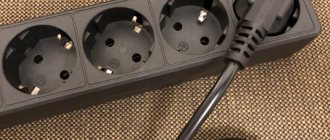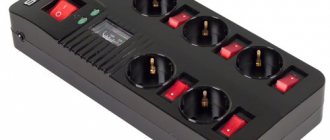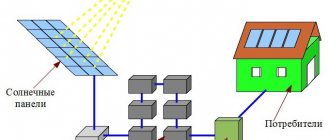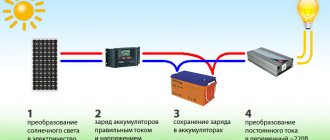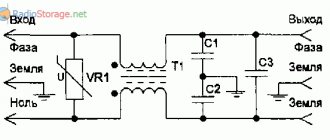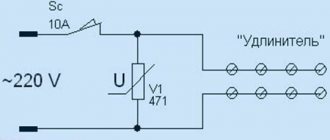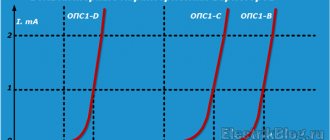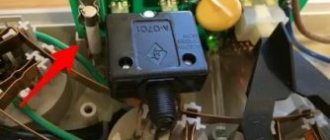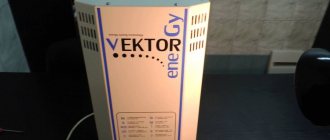The behavior of voltage in a household electrical network is unpredictable. There may be several reasons why the current parameters are outside the permissible deviations. Often these are short-term voltage drops and interference, and sometimes systematic violations of standard standards. The evening voltage in the network differs from the morning one due to the large number of connected devices. Connecting powerful construction or home equipment leads to impulse noise that interferes with the operation of audio and video equipment. The result of temporary and permanent voltage deviations from a sinusoid is deterioration in the quality of work and breakdown of home appliances. One way to avoid trouble is to connect electrical appliances through a surge protector (SF). In simple terms, a surge protector is an extension cord with a toggle switch and a built-in protection unit that provides passive filtering of the input voltage. Let's take a closer look at the design options of different models and the tasks they perform.
What does a surge protector do and what does it protect against?
Problems of the household electrical network that various models of surge protectors struggle with:
- Short circuit. Phase and zero are connected without load. This situation occurs when a wire breaks or a short circuit occurs in any device. In this case, the surge protector turns off all equipment.
- Interference. They arise due to devices connected to the network with switching power supplies. Such equipment includes computers and televisions. High-frequency interference does not damage electronics, but it does degrade its performance. Ripples appear on the screens of analogue TVs, the image is distorted, and extraneous sounds appear in the audio equipment. Extraneous signals distort the operation of sound recording and sound reproducing devices.
- Voltage surges. They can be caused by devices with inductive loads, for example, refrigerators, welding machines.
There is another, unknown to many, danger of interference. Using special equipment, you can gain access to confidential information through electromagnetic noise, which is transmitted through a neutral conductor located outside the house or apartment.
Preparing space for the refrigerator
Before you begin installing the refrigerator, you need to prepare a place for it. First of all, the floor surface at the installation site must be level. In the case where the floor is laid with smooth tiles, you should stock up on special stickers in advance to protect the refrigeration unit from possible slipping.
Its height is adjusted by twisting the legs. In some cases, to ensure that the doors close tightly, the refrigerator is installed with a slight slope towards the rear wall (about 1-2 degrees).
The refrigerator should not be placed next to kitchen furniture or other household equipment without leaving gaps. Due to the fact that the compressor gets very hot during operation, the walls of the refrigerator require free air circulation. If furniture, household appliances or walls interfere with circulation, the life of the refrigerator will be significantly reduced, as will its efficiency. The optimal distance between the walls of the refrigerator and other surfaces is 5 cm.
The proximity of the refrigerator to the stove and radiators should be avoided, since such an installation very often causes excessive overheating of this unit. If proximity to a battery or stove cannot be avoided, then care should be taken to provide a protective barrier. It can be an ordinary sheet of plywood with foil glued to it, which reflects heat very well. It is not advisable to install the refrigerator where it will be exposed to direct sunlight.
When choosing a place for the refrigerator, you should take into account that it runs on electricity, so it needs an electrical outlet. It is advisable that the outlet have a grounding contact. But not every apartment has three-wire wiring. Therefore, when installing a new refrigerator, it would be better to replace the old electrical wires with modern ones, with three cores. If this is not possible, then the refrigerator will have to be connected to the existing network.
Operating principle of a surge protector
Various types of filters combat factors that distort the ideal appearance of an alternating voltage sinusoid:
- High frequency interference. To eliminate them, inductors are used. If a high-frequency current is supplied to them, the resistance in the coils increases, and the sinusoids of the periods leading to high-frequency interference are cut off. The maximum effect can be achieved by using two coils installed on the phase and neutral wires.
- Low frequency interference. Active resistances - resistors - help combat such interference. Network filters use resistors with a nominal value of 0.5-1.0 Ohm. Usually 2 resistors are installed.
The use of a complex of these filters allows you to get rid of high-frequency and low-frequency interference and, as a result, obtain a sinusoid with a frequency of 50 Hz.
Almost all SFs are equipped with a surge protection function. But surge protectors are needed only in the presence of short-term voltage pulses. They do not protect against prolonged excess of this parameter. If the voltage in a given area is too high or too low for a long time, it is recommended to install a stabilizer, since a surge protector is useless in this case.
Selecting operating temperature
After connecting the refrigerator to the mains, you should not immediately fill it with food. It is better to give him time to adapt to the temperature regime. Typically, the refrigerator operating cycle consists of 10 minutes of operation and 20-30 minutes of rest. In order for the refrigerator to start normal operation, at least three cycles must pass from the first start. Some models may take up to three days to become operational.
Depending on the model, the cooling mode may vary. It is recommended to first set the temperature inside the refrigerator to +5 degrees and check the condition of the food. If you find that they are spoiling quickly, the temperature should be reduced.
When setting the optimal mode in the freezer, it should be taken into account that the temperature in it should not be above zero. For long-term storage of products, modern manufacturers recommend a temperature of no lower than -30 degrees, but in practice -20 is usually sufficient. Moreover, the reproduction of microbes stops already at -18 degrees.
The temperature inside the refrigerator can be adjusted using a mechanical thermostat. In this case, the temperature is adjusted by turning the control knob from 1 to 7 or according to the scale drawing to o or “colder”. “1” on the scale corresponds to the highest operating temperature, and “7” or “max” corresponds to the lowest.
Modern refrigerators are often equipped with an electronic temperature setting method. For this purpose, there is a control panel on the door of the unit. The required temperature mode is selected by simply pressing a button. The most advanced models are equipped with touch control panels.
Electronically controlled refrigerators use special sensors - thermistors - instead of thermostats. They are installed on the evaporator, in the refrigerator and freezer compartments, and even on the ice maker, if such an option is present. The sensor readings are sent to the electronic control board and, after processing, serve as a signal to turn the compressor on or off. The electronic control method provides finer and more precise adjustment of the refrigerator’s operating modes.
Device of network filters of different functionality
Cheap SF options are essentially a “carrying device” with surge protection and an “on-off” toggle switch. Overvoltage protection is provided by a varistor.
More expensive surge protector designs include:
- Built-in LC filters, which are inductor coils. Designed to combat high-frequency interference.
- Coils with active resistance - resistors. The presence of these elements in the network filter circuit eliminates low-frequency interference.
- An automatic fuse that cuts off the power supply in case of current overload.
- Metal-oxide varistors, which operate at extremely high voltages, which are possible during a thunderstorm or short circuit.
Standard ratings of used parts:
- The inductance of the coils is 50-200 μH.
- The capacitance of the capacitors is 0.22-1 µF.
- Varistors - designed for voltages up to 470 V.
The circuit may include an overheat sensor that de-energizes the device when the temperature exceeds a set value. The sensor saves the SF from damage in cases where it is located near heating devices or if too high a load is connected to it.
Grounding
If the outlet has a grounding contact, it makes sense to pay attention to carrying a grounding connection (an additional core wire). Why is this necessary?
- The presence of grounding is a plus for the safety of the user and connected equipment. If the device suddenly breaks down, you don’t have to worry about accidentally getting an electric shock.
- In addition, grounding is considered a good barrier to interference. Moreover, both from equipment connected in one circuit, and from what works nearby.
- This model will definitely come in handy if you plan to connect round-the-clock refrigerators, TV, PCs, and other devices.
Design features
The main elements of a modern high-quality surge protector:
- Non-flammable PVC plug. Modern devices use ergonomic plugs of improved design, which ensures easy removal from the socket.
- A wire made of three insulated copper cores in a common sheath. At the point where the wire is connected to the housing, there is an elastic coupling that protects the cable from kinks. Wire length – 1.5, 1.8, 3.0, 4.0, 5.0, 10.0 m.
- Frame. Made from wear-resistant ABS plastic. Available in white, light grey, gray colors. The housing contains interference filtering units, a switch, and a thermal breaker. The outlet openings can be equipped with protective curtains that prevent dirt from getting into them. Safety curtains also prevent small children from touching live parts.
Types of switches:
- Are common. Disconnect all sockets of the device from the power supply at once. This option is most common.
- Individual. Disconnect individual outlets.
- Remote controls. SFs with remote controls are rare and are quite expensive. Convenient for people with limited mobility.
Additionally, the design may contain a light indicator, most often connected to a switch. Indicates whether the device is on or off. Some models are equipped with hinges on the back of the case for wall mounting.
Review of popular models
Let's look at the best surge protectors offered by manufacturers. The first of them is Buro BU-SP5 USB 2A-W. It has an organic appearance, takes up little space, and is relatively inexpensive. The average cost is 790 rubles. The case is white, equipped with 6 European sockets and 2 USB ports that allow you to charge mobile devices. The wire is 5 meters long, the maximum power is no more than 2.2 kW.
The ideal filter for connecting a computer is Pilot X-PRO. The length of the wire, depending on the model, varies from 1.8 to 7 meters. There are 5 euro sockets and one old style. It has an original appearance, reminiscent of a spacecraft in the best traditions of science fiction.
A special advantage is the presence of the Master Control function, which allows you to supply voltage to other consumers after turning on the main one. For example, a modem, printer and monitor can only turn on after the system unit starts. The average price is 1980 rubles.
8 sockets are located at a distance from each other, which allows you to connect any power supply. Cord length – 3 meters. Equipped with light indicators indicating the absence of protection. Price – 3630 rubles.
A properly selected surge protector will significantly extend the life of often expensive household appliances. You shouldn’t skimp on this - it’s better to pay now than to incur much higher repair costs later.
Levels of protection provided by filters of different functionality
Conventionally, the SF can be divided into the following groups according to the degree of protection:
- Basic level (Essential). They are inexpensive, structurally simple, and are used to connect inexpensive home appliances. The difference between inexpensive surge protectors and conventional extension cords is that they provide protection against short-term power surges, take the shock and turn off the devices.
- Advanced level (Home/Office). Widely used for devices used at home and in the office. Presented on the market in a wide range.
- Professional level (Perfomence). Such network filters are capable of eliminating all interference, so they are designed for connecting expensive equipment that is sensitive to interference.
Expert recommendations
To correctly select a filter for the electrical equipment of an apartment or office, there is a procedure for considering the characteristics of the proposed device:
- load power according to the technical data sheet;
- number of simultaneously connected equipment;
- type of sockets;
- length of cable;
- number of fuses;
- mandatory presence of an LED indicator;
- presence of USB output.
According to experts, for home use it is quite enough to have a filter that can withstand up to 10 amperes of load at the same time. To connect a PC, we recommend a device with at least five sockets; the length of the power cable from the socket to the filter can be selected individually, but a standard length of 180 cm is quite sufficient. Among the best devices of this type offered on the market are the following: Defender, BURO, APC and Pilot, as well as Vektor and DNS, which develop and sell models of all 3 protection categories.
Basic parameters of network filters
SF differ in the cross-section of the supply wires. The most common options are cores with a cross section of 0.75 or 1.0 mm2. Such cross-sections are sufficient to provide a maximum load current of 10 A. If it is necessary to provide a rated current of 16 A, then purchase SF with a core cross-section of 1.5 mm2.
When choosing a device, pay attention to the maximum permissible load power that can be connected. This indicator is equal to the product of the maximum permissible load current and network voltage. Almost any model is suitable to ensure the operation of computers and peripheral devices. But before purchasing a surge protector for household appliances, it is necessary to approximately determine the total power of the devices that you plan to connect. If the total power of the equipment is higher than the power permissible for a given model, then it is not worth buying such a SF.
What does it consist of and how is it structured?
Externally, the surge protector looks like a standard extension cord with a cable of various lengths and several sockets for connecting household appliances. But the internal circuit is fundamentally different from ordinary household extension cords. Inside the surge protector, in addition to the pads, there is a protective microcircuit and a fuse. The surge protector also has a power button.
Expensive and well-made surge protectors have a capacitor bank and several chokes and additional protection systems, but inexpensive devices (often made in China) lack such components, but still contain a varistor.
Ways to improve simple network filter circuits
Radio amateurs can upgrade a surge protector with a switch and varistor by improving its circuitry.
To do this you need:
- open the case;
- Solder resistors R1, R2 and inductive coils (chokes) L1, L2 into parallel branches after the switch and varistor;
- alternately close the branches through capacitor C1 and resistor R3;
- terminal capacitor C2 can be installed between sockets anywhere. If there is no space inside the case, you can do without it. In this case, the parameters of capacitor C1 are adjusted.
Recommendations for choosing parts:
- chokes with open ferrite cores with inductance from 10 μH;
- capacitors – 0.22-1.0 µF;
- resistors - for a load of 500 W, resistors of 0.22 Ohm are used, R3 of at least 500 kOhm.
About safe use
The electrical extension cord is intended for temporary connection. At the end of the work, the devices included in it must be disconnected from the network. It is prohibited to disassemble or change the design of the carrier yourself. Especially if electricity and everything connected with it is not your strong point. The cable should not be laid under carpet, linoleum, or through door thresholds. There is a danger of compromising the integrity of the insulation. If the winding is still broken, the electrical device is immediately turned off. Then they fix the damage or buy a new one.
Schemes for connecting the surge protector to the electrical network
In many modern SF models, the ground wire has no connection with the internal circuit, except for the grounding contacts of Euro sockets and Euro plugs. This is a progressive solution that provides an important advantage. When operating from a grounded network, all SF outlets are grounded as required. If there is no ground in the power outlet, then all the socket outlets are connected to each other via a grounding contact. The surge protector itself is not grounded. Let's consider what can happen with different options for connecting a computer and its peripheral devices:
- Connection to a grounded power supply. This is an ideal option, since if there is a breakdown or damage to the insulation of any of the devices, the “excess” voltage is directed to the ground wire.
- Connection to the network without grounding. In this case, the computer case and peripheral devices are connected only by a low-current interface cable. When a potential difference occurs, equalizing currents appear, which, when flowing from a higher potential to a lower one, lead to combustion of the input and output ports of the devices.
- Connection to the network without grounding via SF with sockets connected via a grounding contact. In this case, the equalizing currents will flow through the grounding contacts of the Euro sockets and the ports will remain unharmed.
Conclusion
Experts do not recommend using devices of this type in a chain, in other words, powering one filter from another, which leads to an increase in the current value. It is not recommended to connect equipment with a high input voltage through a network filtering device, such as heating devices (electric heater), air conditioner, vacuum cleaner. It is not recommended to connect a UPS for a computer through a filter; there is a high probability of damage to the “PC uninterruptible power supply” protection circuits.
Similar articles:
- Power lines, their characteristics and classification
- Measuring loop resistance phase - zero
- What is a single line power supply diagram and how to draw it?
